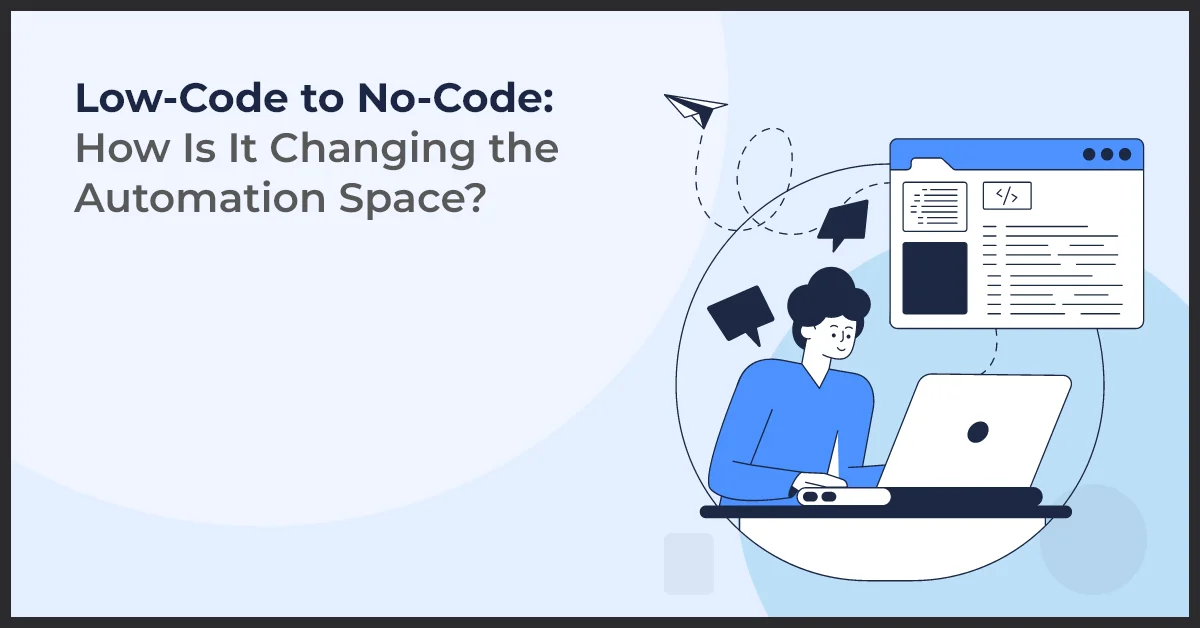Low-Code to No-Code: How Is It Changing the Automation Space?

Published on: September 9, 2022
Updated on: July 04, 2024
660 Views
- Marketing Automation
18 min read
“The best code is no code at all” - Jeff Atwood
In this age, where the demand for software exceeds the supply of coders, no-code tools have taken over and are helping organizations break free from a shortage of developer skills.
In 2017, Chris Wanstrath, the former CEO of GitHub, said that the future of coding would be no coding. He predicted that no-code automation could soon be a considerable alternative to traditional software development programming.
This foresight is becoming a reality with the emergence of various no-code automation tools and advancements in AI technology. In addition to AI chatbots like ChatGPT, Chatsonic, and Chatspot, there is a growing ecosystem of innovative tools such as Bubble, OutSystems, AppSheet, and Adalo.
These platforms enable users to build complex applications through visual interfaces, drag-and-drop functionality, and pre-built components, eliminating the need for extensive coding knowledge.
This paradigm shift transforms how applications are developed, democratizing software creation and empowering individuals with diverse backgrounds to bring their ideas to life.
The projected value of the global low-code platform market is estimated to reach around US$65 billion by 2027.
No-code automation empowers everyday users to drive innovation and develop enterprise-grade solutions without having little to no coding knowledge. It also comes with certain rewards. In this blog post, we will understand those, along with how no-code differs from low-code and whether it suits your business.
What Is No-Code Automation?
A no-code platform is a tool for building software applications that do not necessarily involve coding. This is a popular and promising alternative to traditional software development. No-code tools typically include a user-friendly interface and drag-and-drop capabilities, allowing you to easily explain the general business logic and see the implementation process.
With a visual development interface and a no-code framework, people without technical skills may construct applications by dragging and dropping software components. Users can efficiently create applications with no code without prior coding skills.
How Does No-Code Work?
No-code is a misnomer because there is a lot of coding involved, but it is done in the background and is not visible to business users. No-code tool providers use abstraction and encapsulation to hide the complexity of what users do through straightforward actions such as dragging and dropping components to build an application.
No-code development utilizes a visually integrated development environment, a software suite combining the fundamental tools to create and test software. It frequently employs a model-driven development methodology in which the intended functionality of the software system is mapped out using a software model before any actual coding is done. Model-based testing (MBT) and other techniques can be used to test software after it has been produced.
Benefits of No-Code Automation
User-Friendly Interface
No-code automation platforms offer intuitive, user-friendly interfaces that make it accessible for non-developers to create applications. The drag-and-drop functionality and visual components simplify the development process, eliminating the need for complex coding knowledge.
Empowering Non-Technical Users
No-code automation allows individuals with domain expertise to participate actively in application development. Business users, subject matter experts, and citizen developers can contribute their knowledge and creativity without relying solely on technical teams, empowering them to bring their ideas to life.
Pre-Built Templates and Modules
No-code platforms often provide a library of pre-built templates and modules that can be easily customized to meet specific business needs. This library accelerates development by eliminating the need to start from scratch, enabling faster application prototyping and deployment.
Rapid Iteration and Prototyping
The drag-and-drop interface in no-code automation allows for quick modifications and iterations. Changes can be made in real-time, enabling faster application prototyping and testing. This agility enables businesses to adapt and respond swiftly to evolving requirements or market conditions.
Reduced Dependency on Developers
No-code automation reduces reliance on scarce technical resources. By enabling non-technical users to create applications, businesses can decrease their dependency on developers and utilize their expertise for more complex tasks.
Increased Productivity
No-code automation streamlines the development process, reducing the time and effort required to build applications. With pre-built components and a visual interface, teams can rapidly develop and deploy applications, leading to increased productivity and faster time-to-market.
Lower Development Costs
By promoting independence and productivity, no-code automation helps businesses reduce development costs. The decreased reliance on specialized developers and shorter development cycles result in cost savings, making application development more efficient and cost-effective.
Pro Tip: Leverage the pre-built templates and modules provided by no-code platforms to accelerate development and minimize time-to-market. Customizing these templates allows rapid prototyping and deployment, saving time and resources while ensuring a tailored solution to meet specific business needs.
The Growing Impact of No-Code Automation
Accelerating Adoption and Market Growth
Increasing Demand
The demand for no-code automation continues to rise as organizations seek faster and more agile development approaches. This demand is driven by the need to address resource shortages, reduce development time, and empower citizen developers.
Market Size Expansion
According to Gartner, Inc., the global market for low-code development technologies is expected to reach $26.9 billion in 2023, a 19.6% rise from 2022.
Broader User Base
No-code platforms have democratized software development by enabling users with little to no coding experience to create applications. They have expanded the user base beyond professional developers, allowing subject matter experts and citizen developers to contribute actively to automation initiatives.
Transforming Industries with Successful Implementations
Manufacturing
No-code automation has revolutionized manufacturing processes by enabling the creation of custom applications for inventory management, quality control, and production tracking. This has improved operational efficiency, reduced errors, and increased productivity on the shop floor.
Human Resources
HR departments have leveraged no-code platforms to automate routine tasks such as employee onboarding, leave management, and performance reviews. It streamlines HR operations, reduces administrative burdens, and enhances employee experiences.
Customer Service
No-code automation has transformed customer service operations by enabling the development of chatbots, self-service portals, and automated ticketing systems. These solutions enhance customer satisfaction, improve response times, and reduce support costs.
Future Trends and Predictions
Integration with Emerging Technologies
No-code automation platforms are likely to integrate with emerging technologies such as artificial intelligence (AI), machine learning (ML), and natural language processing (NLP). It will enable the creation of intelligent and predictive applications with minimal coding.
Domain-Specific Solutions
The future of no-code automation will witness the emergence of industry-specific and domain-specific solutions. These platforms will cater to the unique needs and workflows of sectors like healthcare, finance, and logistics, providing tailored automation capabilities.
Collaboration and Governance
As the adoption of no-code platforms increases, organizations will focus on establishing governance frameworks and collaboration practices to ensure security and compliance and maintain consistency across applications developed by citizen developers.
Pro Tip: Stay updated on emerging technologies and industry-specific solutions to leverage the full potential of no-code automation. By integrating these advancements into your automation initiatives, you can enhance your organization's productivity, efficiency, and innovation, gaining a competitive edge in your industry.
Why Should You Use No-Code Automation?
No-code automation is well known for its simplicity and ease of use for non-developers. No-code automation is appealing and allows non-programmers to create workflows quickly with little to no effort. Apart from this, this automation solution has several advantages:
1. Better Agility
No-code helps you eliminate any complex business process and replaces them with pre-built modules. Most of the development is done via the drag-and-drop interface. Put another way, no-code architecture tools abstract away a lot of the complexity of building the front-end user experience by providing rich models to use and adjust. The time you save by not having to start from scratch with UI/UX will enable you to spend more time with your clients and give them a better app experience.
2. Reduced Costs
DevOps approaches for traditional software development are expensive, as you must recruit people with advanced technical skills. You may also need to employ front-end and back-end developers, financial and security consultants, and even software and cloud experts to design the project. No-code might not eliminate the necessity for the cost of employing developers. Still, they undoubtedly provide non-developers enough power to take the initiative and develop apps independently.
Using no-code automation, you can complete projects without depending on the availability of resources. Instead, you'll promote independence and productivity across your IT and non-IT staff.
3. Easily Alterable
Traditional hand coding has the drawback that you can't change a capability or feature at any time, especially if you're writing in a language you don't know. You can do it without a code. If something needs to be changed, you can modify it in a matter of hours by simply implementing new logic with no-code automation.
The Future of No-Code Automation
The Ongoing Demand for Software Development Outpacing IT Capabilities
Increasing Complexity
The demand for software applications continues to grow, fueled by digital transformation initiatives, emerging technologies, and evolving customer expectations. However, traditional IT departments often struggle to meet this demand due to resource constraints and time-consuming development processes.
Addressing the Skills Gap
The shortage of skilled developers further exacerbates the challenge of meeting the demand for software development. No-code automation provides a solution by actively enabling non-technical users to participate in application development, bridging the skills gap, and empowering organizations to create software more efficiently.
Potential for No-Code Automation to Make Businesses More Responsive and Self-Sufficient
Empowering Citizen Developers
No-code automation allows individuals without extensive coding knowledge to contribute to the development process. Business users, subject matter experts, and citizen developers can take the lead in creating applications that meet their specific needs. It empowers departments and teams to be more self-sufficient and responsive to their unique requirements.
Agile Iteration and Faster Time-to-Market
Businesses can rapidly prototype, test, and iterate on applications with no-code platforms. The visual interface and drag-and-drop capabilities enable quick adjustments and modifications, reducing development cycles and accelerating time-to-market for new products or services. This agility allows businesses to respond promptly to market changes and customer feedback.
Role of No-Code Automation in Driving Business Strategies and Growth
Enabling Innovation
No-code automation empowers businesses to experiment, innovate, and explore new ideas without being constrained by the limitations of traditional development approaches. It fosters a culture of innovation, where individuals can quickly transform their ideas into functional applications, driving creativity and enabling rapid experimentation.
Streamlining Processes and Increasing Efficiency
No-code automation allows businesses to automate repetitive and manual tasks, streamlining workflows and increasing operational efficiency. Organizations can free up valuable time and resources by automating these processes, redirecting them towards higher-value activities that drive growth and strategic initiatives.
Enhancing Customer Experiences
No-code automation enables businesses to create personalized and tailored applications for their customers. By developing customer-facing applications with no-code platforms, organizations can provide seamless and engaging experiences, resulting in higher customer satisfaction, increased loyalty, and, ultimately, business growth.
Pro Tip: Encourage cross-functional collaboration and knowledge sharing within your organization to fully leverage the potential of no-code automation. By involving business users, subject matter experts, and citizen developers in the development process, you can foster innovation, streamline processes, and enhance customer experiences, driving business growth and success.
What Is a Low-Code Platform?
A low-code platform is a software development environment that allows users to create applications with minimal hand-coding and a visual development approach. It provides tools, pre-built components, and visual interfaces that simplify the application development. Low-code platforms aim to accelerate the development cycle, reduce the need for extensive coding knowledge, and enable a broader range of users, including citizen developers and business users, to participate in the development process.
How Does a Low-Code Platform Work?
Visual Development Environment
Low-code platforms offer a visual development environment where users can visually design the user interface, workflows, and data models. This environment typically includes a drag-and-drop interface, allowing users to add and arrange pre-built components or custom elements within their application.
Pre-Built Components and Templates
Low-code platforms provide a library of pre-built components and templates that users can leverage to build applications. These components encompass various functionalities, including UI elements, data connectors, integrations, and business logic, and can be easily customized to fit specific requirements.
Configuration and Customization
Users can configure the behavior and properties of the pre-built components through intuitive settings and configuration options provided by the low-code platform. It allows easy customization of the application's functionality, look and feel, and business processes.
Integration Capabilities
Low-code platforms often offer seamless integration with other systems and services. They provide connectors and APIs that enable users to connect their applications to external databases, third-party services, or legacy systems, facilitating data exchange and interoperability.
Visual Logic and Workflow Design
Low-code platforms allow users to define the application's logic and workflows using visual tools like flowcharts or diagrams. Users can visually map out the sequence of actions, decision points, and data flows within the application, making it easier to understand and maintain its functionality.
Rapid Iteration and Deployment
Low-code platforms enable rapid application iteration and deployment. Changes and updates to the application can be made quickly through the visual interface, allowing for agile development and iterative improvements. Low-code platforms often support one-click deployment to various environments, making publishing and distributing applications easier.
Collaboration and Version Control
Many low-code platforms facilitate collaboration among development teams, business users, and stakeholders. They provide features for sharing and reviewing work, managing access controls, and ensuring version control, allowing multiple users to work on the same application and track changes simultaneously.
Pro Tip: Enabling real-time collaboration and effective version management can streamline communication, track changes, and maintain project integrity throughout the development process.
The Rise of Low-Code Platforms
Low-Code Platforms and Their Main Features
Visual Modeling
Low-code platforms provide a visual development environment where users can visually create application components, define data structures, and design user interfaces. This visual modeling approach simplifies the development process and reduces the need for extensive coding.
Rapid Application Development
Low-code platforms facilitate rapid application development by offering a range of pre-built modules and templates. These components can be customized to meet specific business requirements, accelerating the development cycle and minimizing the need for extensive coding from scratch.
Drag-and-Drop Functionality
Low-code platforms often include drag-and-drop functionality, allowing users to easily add and arrange pre-built components and modules within their applications. This feature streamlines the application development process by eliminating the need for manual coding and enabling a more intuitive approach to building applications.
Pre-Built Components and Templates
Low-code platforms have a library of pre-built components, such as user interface elements, database connectors, and integrations. These components can be easily integrated into applications, saving development time and effort by leveraging existing functionalities.
Workflow Automation
Many low-code platforms offer built-in workflow automation capabilities. Users can design and automate business processes using visual tools, reducing manual effort and streamlining workflows. This feature enhances efficiency and helps organizations automate repetitive tasks.
Examples of Popular Low-Code Platforms and Their Success Stories
OutSystems
OutSystems is a leading low-code platform known for its robust application development, integration, and deployment capabilities. Organizations in various industries, such as Randstad, Logitech, and Deloitte, have used it to create scalable and innovative applications that drive digital transformation.
Mendix
Mendix is a low-code platform that empowers businesses to build and deploy enterprise-grade applications quickly and easily. Companies like Siemens, Philips, and KPN have successfully utilized Mendix to accelerate application development, improve efficiency, and enhance customer experiences.
Microsoft Power Apps
Microsoft Power Apps is a low-code platform that allows users to create custom business applications and workflows. It integrates seamlessly with other Microsoft products and services, enabling organizations to leverage existing infrastructure and enhance productivity. Companies like Chevron, Shell, and L'Oréal have leveraged Power Apps to automate processes and streamline operations.
Pro Tip: When selecting a low-code platform, prioritize solutions that offer comprehensive visual modeling capabilities, extensive pre-built components, and robust workflow automation features.
The Future of Low-Code Automation
Increased Adoption
The adoption of low-code platforms is expected to rise significantly in the coming years. Businesses across industries recognize low code's value in accelerating application development, improving agility, and empowering citizen developers. As awareness and understanding of low-code platforms increase, more organizations will embrace this approach to meet their digital transformation needs.
Advanced AI Integration
Artificial intelligence (AI) integration within low-code platforms is a notable trend for the future. AI capabilities like natural language processing, image recognition, and predictive analytics will be embedded into low-code platforms. This integration will enable the creation of intelligent and data-driven applications, further enhancing their functionality and automation capabilities.
Robust Ecosystem and Marketplace
The low-code ecosystem will continue to expand, with more pre-built components, templates, and integrations available in marketplaces. These marketplaces will allow developers and citizen developers to leverage existing resources, reducing development time and effort. It will also foster collaboration and knowledge sharing among users, driving innovation and expanding the capabilities of low-code platforms.
Integration with Emerging Technologies
Low-code platforms will integrate with emerging technologies such as blockchain, Internet of Things (IoT), augmented reality (AR), and virtual reality (VR). This integration will enable the development of applications that leverage these technologies to create immersive experiences, optimize processes, and solve complex business challenges.
Mobile-First Approach
The future of low-code will emphasize mobile application development. With the proliferation of smartphones and the increasing demand for mobile solutions, low-code platforms will provide enhanced capabilities for building responsive and feature-rich mobile applications. It will enable organizations to deliver seamless user experiences across various devices and platforms.
Intelligent Automation and Robotics Process Automation (RPA)
Low-code platforms will incorporate intelligent automation capabilities, including RPA, to automate repetitive tasks and streamline business processes. This integration will allow for the creation of end-to-end automated workflows, optimizing efficiency and reducing manual effort.
Focus on User Experience
User experience will remain a critical aspect of low-code development. Low-code platforms will continue to provide intuitive and user-friendly interfaces, enabling citizen developers and business users to create applications focusing on usability and aesthetics. Design thinking principles and user-centered approaches will be integrated into low-code development practices.
Hybrid Development Approaches
Low-code platforms will enable hybrid development approaches, combining traditional coding with visual development. This flexibility will accommodate the needs of professional developers who may require custom code for specific requirements while still leveraging the speed and efficiency of low-code development for other parts of the application.
Pro Tip: Embrace the expanding ecosystem and marketplace of low-code platforms to leverage pre-built components, templates, and integrations, enabling faster development and fostering collaboration.
Understanding the Difference Between No-Code and Low-Code
Most of you might think that low-code and no-code terms are interchangeable, but they are not.
Declarative programming or "no code" automation is primarily about what you want rather than how you get it. Code is a representation of instructions that informs platforms on how to achieve the desired functionality in conventional software application platforms. Because there is no code, the creator specifies what the program does instead of defining how an app works.
On the other hand, non-technical users can utilize low-code platforms as well, but eventually, they will need a developer to complete the task. Users can build their applications up to a certain point using low-code platforms or rapid application tools. Then, they can hire a developer to write or customize the remaining portions. The platform receives instructions from developers on how to use the components.
| No-Code Platforms | Low-Code Platforms | |
| User Base | Non-technical users, citizen developers, subject matter experts | Non-technical users, citizen developers, subject matter experts, developers |
| Technical Skills Required | Little to no coding knowledge is required | Some coding knowledge or developer involvement may be required |
Development Process | Visual development interface, drag-and-drop functionality | Visual modeling, pre-built components, and templates |
| Extensibility | Limited customization and scalability options | High customization and scalability options |
| Developer Involvement | Minimal or no developer involvement is required | Developers may be required for complex customizations or integrations |
| Time-to-Market | Rapid prototyping and faster development cycles | Development cycles may be longer, especially for complex applications |
| Complexity | Abstracts away coding complexity, focuses on what the program does | Involves coding, focuses on how the program works |
| Flexibility | Limited flexibility due to pre-built components and templates | Greater flexibility to customize and tailor applications |
| Target Users | Empowers non-technical users, subject matter experts | Suitable for both non-technical and technical users |
| Examples | Bubble, Adalo, OutSystems | Mendix, Microsoft Power Apps, Appian |
Key Takeaways
- No-code automation revolutionizes software development by empowering non-technical users to create applications without extensive coding knowledge. This democratization of software creation is driven by user-friendly interfaces, drag-and-drop functionality, and pre-built components, facilitating rapid application development.
- No-code platforms offer numerous benefits, including better agility, reduced costs, and easily alterable applications. By abstracting away coding complexity and providing intuitive tools for application development, these platforms enable organizations to innovate, streamline processes, and enhance productivity.
- The future of automation lies in the increased adoption of low-code and no-code platforms, integration with emerging technologies, and a focus on user experience. These platforms will empower citizen developers, drive business strategies, and transform industries by enabling rapid prototyping, intelligent automation, and mobile-first development.
Conclusion: A Glimpse Into the Future
The future is no-code automation, and it seems as bright as the present. Since the demand from business professionals exceeds the ability of IT departments to develop and maintain applications. Also, Gartner predicts that nearly 65% of application development will be done by no-code automation by the end of 2024.
No-code automation makes businesses and IT professionals more responsive and self-sufficient.
At Growth Natives, we work at something similar, making automation easier for your business so that you can eliminate unimportant tasks and focus on better strategies to drive your business forward. Looking for more help on no-code automation? Let us experts take the wheel! Write to us at info@growthnatives.com.
Frequently Asked Questions
Low-code test automation requires minimal manual coding to create automated test scripts. It often involves visual interfaces and pre-built components with some level of custom coding. No-code test automation involves creating automated test scripts without manual coding, relying entirely on visual interfaces and pre-built components.
No code allows building applications or automating processes without writing code, relying solely on visual interfaces and pre-built components. Low code requires minimal manual coding to build applications or automate processes, offering visual interfaces, pre-built components, and the option for some custom coding.
Automation in no-code involves automating tasks, workflows, or processes using platforms that require no manual coding. Users leverage visual interfaces and pre-built components to create automated solutions effortlessly.
Benefits of Low-Code: Accelerated development, reduced dependency on coding expertise, flexibility with some coding options.
Benefits of No-Code: Accessibility to non-technical users, faster prototyping, reduced dependency on developers.
Low-Code Automation: Involves streamlining development using visual interfaces and pre-built components with minimal manual coding.
Traditional Development: Requires manual coding from scratch, longer development cycles, and extensive programming knowledge.
- Organizations aiming to accelerate application development.
- Business users seeking active involvement in application creation.
- Companies face resource constraints or a shortage of skilled developers.
No-code automation involves automating tasks, workflows, or processes without manual coding. Users rely exclusively on visual interfaces and pre-built components.
Low-code automation entails automating tasks, workflows, or processes with minimal manual coding. It utilizes visual interfaces and pre-built components and offers limited custom coding options.



